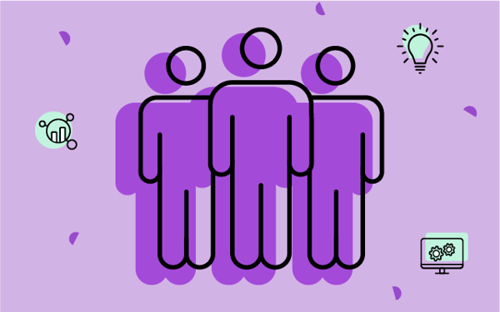For nearly a decade, Crayon has been helping people like you build excellent compete programs—programs that increase win rates and influence executive decision-making.
We decided to take everything we've learned over the years and condense it into a practical how-to guide: The 6 Levels of Compete Program Maturity (and How to Get to Level 6).
The 6 levels of maturity are as follows:
- Level 1: You have published a battlecard for at least one of your Tier 1 competitors.
- Level 2: You have published a battlecard for each of your Tier 1 competitors.
- Level 3: 25% of your sales reps use your battlecards at least once a month.
- Level 4: 50% of your sales reps use your battlecards at least once a month.
- Level 5: You report quantitative & qualitative win-loss findings once a quarter.
- Level 6: You use CI to help executive leaders make decisions.
If you're at Level 2 or Level 3, you're reading the right blog post.
How to advance from Level 2 to Level 3
You have a battlecard for each of your Tier 1 competitors — now what? To advance to Level 3, you must get 25% of your sales reps to use the battlecards monthly.
There are 3 reasons why CI programs fail to sustain this level of battlecard adoption:
- The battlecards are unhelpful.
- The battlecards are difficult to find.
- The sales team forgets about the battlecards.
In the section on advancing to Level 1, you learned how to make your battlecards helpful and easy to find. So, in this section, you’ll learn how to keep your battlecards at the top of your sellers’ minds.
Simply put, you need to over communicate. At least twice per month, you should remind your sellers that the battlecards exist and that they’re here to help. It’s also valuable to set specific expectations early on with your sellers, e.g. “You should be reviewing this competitive battlecard roughly once a week given that this particular competitor is in more than 50 percent of our deals.”
The million dollar question: How do you over communicate without annoying your sellers? By adhering to the two V’s: value and variety. Let’s start with value.
Value
A surefire way to annoy your sellers is by copying and pasting the same reminder every two weeks without adding anything new. By the third or fourth reminder, they’ll tune you out.
Every time you remind your sellers about the battlecards, you must give them something of value: an updated talk track, a new customer quote, a new win story with key takeaways – something new or improved that will make it easier for them to win competitive deals. So rather than saying, “Hey everyone, just another reminder that you can find the battlecards in Highspot,” you can instead say, “Hey everyone, just added a brand new customer quote to the Competitor X battlecard that further validates our differentiators. Go check it out in Highspot!”
Variety
Next we have variety, which applies to both who is sending the reminder and how they’re sending the reminder. Remember in the previous section when we recommended that you co-present your latest battlecard with a tenured seller? Every now and then, that same seller – or someone else on the team who’s earned a similar level of respect – should be the one who reminds everyone about the battlecards. Not only because the message means more coming from a seller, but it also helps counteract the “tune out” effect that can happen when the same person says (basically) the same thing at the same time every week.
The principle of variety also applies to how you remind the sales team about your battlecards. Should you alternate between reminding them with a Slack post and reminding them with an email? No, that would be confusing and probably counterproductive. But in addition to your usual Slack post, maybe you host a monthly “trivia night” where you break the sellers into teams for a friendly competition to see who knows the most about a certain competitor.
Or maybe you join their standing team meeting once a month and deliver a special presentation with a fun theme – like a baseball-themed presentation titled “How to Hit a Home Run When Competitor X Is On the Mound” or a Matt Damon-themed presentation titled “How to Be Wicked Smart About Competitor Y.” Obviously, the theme needs to be familiar to your audience, and it shouldn’t distract from the content of the presentation, but you get the idea – it’s a fun way to mix things up and keep your battlecards top of mind.
Emerging champions
So, to recap the two V’s: (1) always have something new or improved to share with the sellers when you remind them about the battlecards; (2) keep things interesting by enlisting the help of tenured sellers and by mixing in a fun game or presentation once a month.
If you overcommunicate and stick to the two V’s, you will get the ball rolling – you will notice an uptick in battlecard adoption. To keep that momentum going and accelerate adoption, we suggest keeping an eye out for emerging champions – sellers who are using the battlecards and winning more deals as a result.
Think about it in marketing terms. As a marketer, you keep an eye out for successful customers because their stories can help you attract more customers. Battlecard adoption works the same way. Every time a seller wins a competitive deal, you have an opportunity to create a case study. But rather than publishing a page on your website, you can partner with the seller to create a brief presentation: “How I Won a $100K Deal Against Competitor Z” or something like that. Success stories told in sellers’ favorite language (money) are very powerful, so you should consider creating them in addition to trivia nights and themed presentations – hello, variety!
How to advance from Level 3 to Level 4
Keep applying the best practices from the previous section that got you to Level 3.
How to advance to Level 6
Want to learn how to build the best compete program possible? Download The 6 Levels of Compete Program Maturity (and How to Get to Level 6) today.

Related Blog Posts
Popular Posts
-
 How to Create a Competitive Matrix (Step-by-Step Guide With Examples + Free Templates)
How to Create a Competitive Matrix (Step-by-Step Guide With Examples + Free Templates)
-
 The 8 Free Market Research Tools and Resources You Need to Know
The 8 Free Market Research Tools and Resources You Need to Know
-
 Sales Battlecards 101: How to Help Your Sellers Leave the Competition In the Dust
Sales Battlecards 101: How to Help Your Sellers Leave the Competition In the Dust
-
 6 Competitive Advantage Examples From the Real World
6 Competitive Advantage Examples From the Real World
-
 How to Measure Product Launch Success: 12 KPIs You Should Be Tracking
How to Measure Product Launch Success: 12 KPIs You Should Be Tracking



